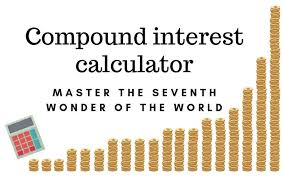Empower your financial future with our top-rated investment tool Compound Investment Calculator.This essential calculator will help you unlock the full potential of compound interest, allowing you to optimize your investment strategy, plan for consistent growth, and achieve your financial goals with confidence. Investment Calculator Monthly will optimize your investment strategy for high return.
Investment Calculator
Different Types of Investments ?
We will explore some of the most common types of investments and how they work.
Stocks
One of the most well-known types of investments is stocks. When you buy a stock, you are purchasing a small piece of ownership in a company. As the company grows and earns profits, the value of your stock may increase, allowing you to sell it for a profit. However, stocks can also be volatile and risky, as their value can fluctuate based on various factors such as economic conditions, industry trends, and company performance.
Bonds
Bonds are another popular type of investment that involves loaning money to a government or corporation. In return, the borrower pays interest on the loan, and the bondholder receives a fixed income stream. Bonds are generally considered less risky than stocks, but they also offer lower returns.
Real Estate
Real estate investment involves purchasing and owning property with the goal of generating income through rent or selling the property for a profit. Real estate can provide a steady stream of passive income, but it also requires a significant upfront investment and ongoing maintenance costs.
Mutual Funds
Mutual funds are a type of investment that pools money from multiple investors to buy stocks, bonds, or other securities. This allows investors to access a diversified portfolio of investments that may not be available to them individually. Mutual funds are managed by professional fund managers, who make investment decisions on behalf of the investors. While mutual funds can be a good way to diversify your portfolio, they also come with fees and expenses.
Exchange-Traded Funds (ETFs)
ETFs are similar to mutual funds, but they trade like stocks on a stock exchange. ETFs can provide access to a wide range of investments, including stocks, bonds, and commodities, at a lower cost than actively managed mutual funds. However, like any investment, ETFs come with risks, and it's essential to do your research before investing.
Cryptocurrencies
Cryptocurrencies like Bitcoin, Ethereum, and Dogecoin have become increasingly popular in recent years. These digital assets operate independently of central banks and governments and are stored in digital wallets. While cryptocurrencies have the potential for high returns, they are also highly volatile and can be subject to security risks.
In conclusion, there are many different types of investments available, each with its own risks and rewards. By understanding the basics of each type of investment, you can make informed decisions about how to invest your money and work towards achieving your financial goals. Remember, investing always comes with risks, and it's important to do your due diligence and seek professional advice before making any investment decisions.
Why should you invest?
We'll explore why you should invest and the advantages of investing your money.
Beat Inflation
One of the most compelling reasons to invest is to beat inflation. Inflation is the rate at which the prices of goods and services increase over time. Inflation can erode the purchasing power of your money, making it harder to achieve your financial goals. By investing your money, you can earn returns that exceed the rate of inflation, allowing you to preserve and grow your wealth over time.
Build Wealth
Investing can be an effective way to build wealth over the long term. By investing your money, you have the potential to earn returns that exceed what you could earn through saving or leaving your money in a bank account. Over time, these returns can compound, allowing your investments to grow exponentially.
Meet Long-Term Goals
Investing is a crucial tool for achieving long-term financial goals, such as saving for retirement or funding your children's education. By investing your money in a diversified portfolio of assets, you can benefit from long-term growth and earn returns that can help you achieve your financial objectives.
Generate Passive Income
Investing can also provide a source of passive income, which can be a valuable source of cash flow over time. By investing in assets such as real estate or dividend-paying stocks, you can generate income that can supplement your regular income or help you achieve financial independence.
Diversify Your Portfolio
Investing allows you to diversify your portfolio and spread your risk across multiple assets. By investing in a mix of stocks, bonds, real estate, and other assets, you can reduce your exposure to any one asset class and protect your portfolio against market volatility.
Take Advantage of Tax Benefits
Certain types of investments offer tax benefits that can help you reduce your tax liability and keep more of your money in your pocket. For example, contributions to a retirement account such as a 401(k) or IRA may be tax-deductible, allowing you to reduce your taxable income and save money on taxes.
investing your money is an essential step towards achieving your long-term financial goals. By investing, you can beat inflation, build wealth, generate passive income, and diversify your portfolio.
How much should you save vs. invest?
Understanding Saving vs. Investing
Before we dive into how much you should save versus invest, it's important to understand the differences between these two activities.
Saving is the process of setting aside money for short-term goals or emergencies. This money is typically stored in a savings account, money market account, or other low-risk investment. The goal of saving is to have access to funds when you need them, without risking the loss of your principal investment.
Investing, on the other hand, involves purchasing assets with the intention of generating long-term returns. Investments can include stocks, bonds, mutual funds, real estate, and other assets that have the potential to increase in value over time. Investing involves taking on more risk than saving, but it also has the potential for higher returns.
How Much Should You Save?
When it comes to saving, there is no one-size-fits-all answer to how much you should save. The amount you save will depend on your income, expenses, and financial goals. However, most financial experts recommend saving at least 20% of your income.
One way to determine how much you should save is to follow the 50/30/20 rule. This rule suggests that you allocate 50% of your income to necessities like housing, food, and utilities, 30% to discretionary spending, and 20% to saving and investing.
Another factor to consider when deciding how much to save is your emergency fund. Most experts recommend having at least three to six months' worth of living expenses saved in an emergency fund. This fund can provide a safety net in case of unexpected expenses, job loss, or other emergencies.
How Much Should You Invest? - Pick an investment strategy
we'll explore how to decide how much to invest and ensure that you're investing reasonably.
- Set your financial goals
Before you can determine how much to invest, you need to set your financial goals. Your goals will dictate the amount you need to invest and the type of investments you should consider. For example, if you're investing for retirement, you may need to invest more aggressively to achieve higher returns. Conversely, if you're saving for a short-term goal, such as a down payment on a home, you may need to invest more conservatively.
- Determine your risk tolerance
Your risk tolerance is the amount of risk you're willing to take on when investing. Generally speaking, higher risk investments have the potential for higher returns, but they also come with a greater risk of loss. It's essential to determine your risk tolerance before investing to ensure that you're comfortable with the level of risk you're taking on.
- Consider your time horizon
Your time horizon is the length of time you have to achieve your financial goals. Generally speaking, the longer your time horizon, the more aggressive you can be with your investments. This is because you'll have more time to ride out any market fluctuations or downturns.
- Calculate your investment budget
Once you've established your financial goals, risk tolerance, and time horizon, you need to determine your investment budget. Your investment budget is the amount of money you can realistically invest each month or year. It's important to be realistic when calculating your investment budget to ensure that you can maintain your investment strategy over the long term.
- Diversify your portfolio
Diversification is the key to managing risk when investing. By investing in a variety of assets, such as stocks, bonds, and real estate, you can minimize your exposure to any single asset class. Diversification can also help you achieve a more stable rate of return over time.
- Monitor and adjust your investments
Investing is not a set-it-and-forget-it activity. It's essential to monitor your investments regularly and adjust your strategy as needed. This could mean rebalancing your portfolio periodically or changing your investments to align with your changing financial goals.
7.Choose your investment approach
Once you've established your financial goals and risk tolerance, it's time to choose your investment approach. There are many different investment strategies to consider, including:
- Buy and hold: This approach involves buying and holding stocks, bonds, or other investments for the long term, typically five to ten years or more. Buy and hold investors believe that the market will eventually trend upward, and that short-term fluctuations are temporary.
- Value investing: This approach involves identifying undervalued investments, such as stocks or bonds, that are trading below their intrinsic value. Value investors believe that the market will eventually recognize the true value of these investments, leading to a price increase.
- Growth investing: This approach involves investing in companies that are expected to grow faster than the overall market. Growth investors are willing to pay a premium for these investments because of their potential for higher returns.
- Income investing: This approach involves investing in assets that generate regular income, such as dividend-paying stocks or bonds. Income investors are typically more conservative and prioritize generating regular cash flow over long-term capital appreciation.
Investing is an essential aspect of personal finance, but it's important to invest reasonably to ensure that you're not taking on excessive risk or missing out on growth opportunities. By setting your financial goals, determining your risk tolerance and time horizon,calculating your investment budget, diversifying your portfolio, and monitoring and adjusting your investments regularly, you can create a personalized investment strategy that aligns with your goals and values.
Start investing as early as possible
We'll explore the benefits of starting investing as early as possible and provide tips for getting started.
The Power of Compounding
Compounding is the process of earning interest on your investment returns, which in turn generates even more returns. The earlier you start investing, the more time your money has to compound. Even small investments made early on can grow to significant sums over time thanks to the power of compounding.
For example, let's say you invest $5,000 at age 25 and earn an average annual return of 8%. If you continue to make no additional investments and simply let your money grow, that initial investment will grow to over $68,000 by age 65. But if you wait until age 35 to invest that same $5,000, it will only grow to just over $28,000 by age 65.
The Benefits of Starting Early
Starting to invest as early as possible has many benefits, including:
More Time for Growth: The longer your investments have to grow, the more they can compound and increase in value.
More Flexibility: Starting early gives you more flexibility to take risks and try different investment strategies since you have more time to recover from any losses.
Higher Returns: Historically, the stock market has provided higher returns over the long-term than other investment options like bonds or savings accounts. Starting early means you have more time to take advantage of these higher returns.
Tips for Getting Started
If you're ready to start investing as early as possible, here are some tips to help you get started:
Start Small: You don't need a large sum of money to start investing. Many investment platforms allow you to start with as little as $25.
Set Investment Goals: Determine your investment goals and create a plan to achieve them. This will help you stay focused and on track.
Diversify Your Portfolio: Diversification helps to reduce risk by investing in a variety of asset classes.
Seek Professional Advice: Consider working with a financial advisor who can help you create a personalized investment strategy based on your goals and risk tolerance.

Top Compound Interest Calculator
Building wealth through investments requires careful planning, strategy, and an understanding of the power of compound interest. To make the most of your investments, it's crucial to have reliable tools that can help you analyze and optimize your portfolio. In this article, we will explore the usage and benefits of three top investment calculators: the Compound Investment Calculator and Investment Calculator Monthly.
Compound Investment Calculator: Forecasting Your Financial Future
A Compound Investment Calculator is a powerful tool that allows you to estimate the future value of your investments based on the power of compound interest. By inputting your initial investment, interest rate, compounding frequency, and investment duration, this calculator can provide you with a projection of your future wealth.
Benefits:
- Financial planning: This calculator enables you to visualize the growth potential of your investments, helping you plan for your financial future.
- Customization: You can experiment with different investment scenarios by adjusting the interest rate, compounding frequency, and time frame to see how they affect your investment's growth.
- Informed decision-making: By understanding the impact of compound interest on your investments, you can make better investment choices that align with your financial goals.
Investment Calculator Monthly: Planning for Consistent Growth
The Investment Calculator Monthly is designed to help you estimate the future value of your investments when you make regular monthly contributions. By entering your initial investment, monthly contributions, interest rate, and investment duration, this calculator will display the projected value of your investments over time.
Benefits:
- Budgeting: This calculator allows you to plan your monthly savings and investment contributions, helping you stay on track with your financial goals.
- Compound growth: By making regular monthly contributions, you can maximize the power of compound interest and grow your wealth faster.
- Goal-setting: Use this calculator to set realistic investment targets and monitor your progress toward achieving them.
FAQ
What is compound investment, and how does it work?
- Compound Investment: Compound investment, often referred to as compound interest or compound growth, involves reinvesting earnings or returns on an investment. Instead of withdrawing these gains, they are added to the principal amount, allowing the investment to grow exponentially over time.
How does a Compound Investment Calculator work?
- A Compound Investment Calculator is a tool that helps you estimate the future value of an investment with compound interest. You input the principal amount, the annual interest rate, the frequency of compounding (e.g., monthly), and the investment period. The calculator then computes the projected value of your investment.
What's the advantage of using compound investment over simple interest?
- Compound investment offers the advantage of exponential growth. As your earnings or interest are reinvested, your investment can grow significantly over time, potentially resulting in higher returns compared to simple interest, which offers linear growth.
How do I use the Compound Investment Calculator to plan my investments?
- To plan your investments with a Compound Investment Calculator, start by entering the initial principal amount. Then, input the annual interest rate as a decimal (e.g., 5% as 0.05), specify the compounding frequency (e.g., monthly), and set the investment period. The calculator will provide an estimate of the investment's future value, allowing you to make informed investment decisions.
Is the Compound Investment Calculator suitable for long-term investments only?
- No, the Compound Investment Calculator is suitable for both short-term and long-term investments. It can be used to assess the impact of compound growth over various timeframes, from months to years.
Can I calculate monthly investments using the Compound Investment Calculator?
- The Compound Investment Calculator primarily focuses on estimating the future value of a lump-sum investment with compound interest. To calculate monthly investments, you'd need a specialized Investment Calculator Monthly, which considers regular contributions made over time.
How can I compare different investment scenarios using these calculators?
- To compare different investment scenarios, use the Compound Investment Calculator to assess the impact of varying principal amounts, interest rates, and compounding frequencies. For monthly investments, utilize an Investment Calculator Monthly to project the growth of regular contributions.
What's the key takeaway when it comes to compound investment and investment calculators?
- The key takeaway is that compound investment allows your money to grow exponentially over time by reinvesting your earnings. Investment calculators, such as the Compound Investment Calculator and Investment Calculator Monthly, help you make informed investment decisions by estimating the future value of your investments under different scenarios.
Conclusion
Utilizing the right investment calculators can play a crucial role in optimizing your investment strategy and achieving your financial goals. The Compound Investment Calculator and Investment Calculator Monthly are powerful tools that can help you visualize the potential growth of your investments, plan your savings, and make informed decisions. By leveraging these calculators, you can harness the power of compound interest and pave the way to a prosperous financial future.





